Gallery Collection
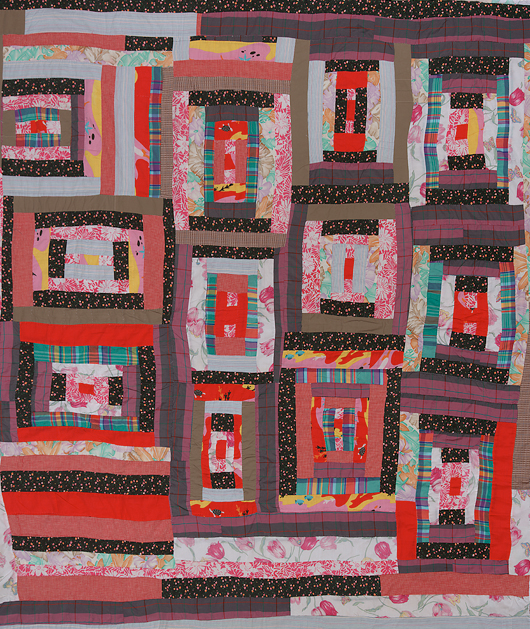
Lucy Mingo
Housetop, Log Cabin Variation, 1985
Collection of Souls Grown Deep Foundation, photo by Stephen Pitkin
Gee’s Bend is a small, isolated African American community in Alabama where generations of women have passed down the art of quilting since the 19th century. Known for their bold designs and improvisational style, Gee’s Bend quilts have become a vital part of American art history. Lucy Mingo’s Housetop, Log Cabin Variation (1985) is one example of this tradition, reflecting the movement’s deep roots in community, resilience, and creative expression.
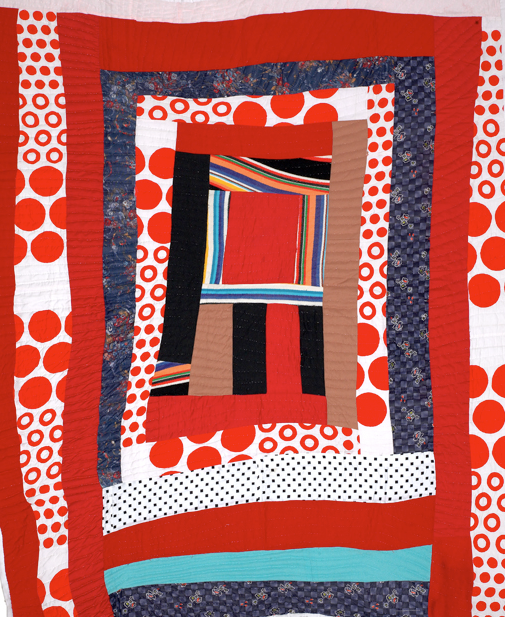
Loretta Pettway
Housetop Variation, 2003
Collection of Souls Grown Deep Foundation, photo by Stephen Pitkin
Today, the Gee’s Bend quilts are internationally recognized as a key element of American folk art and are included in the permanent collections of over 40 museums across three continents.
Loretta Pettway’s Housetop Variation (2003) is a striking example of the movement’s contemporary expressions, continuing the tradition through bold color and rhythmic, geometric design.
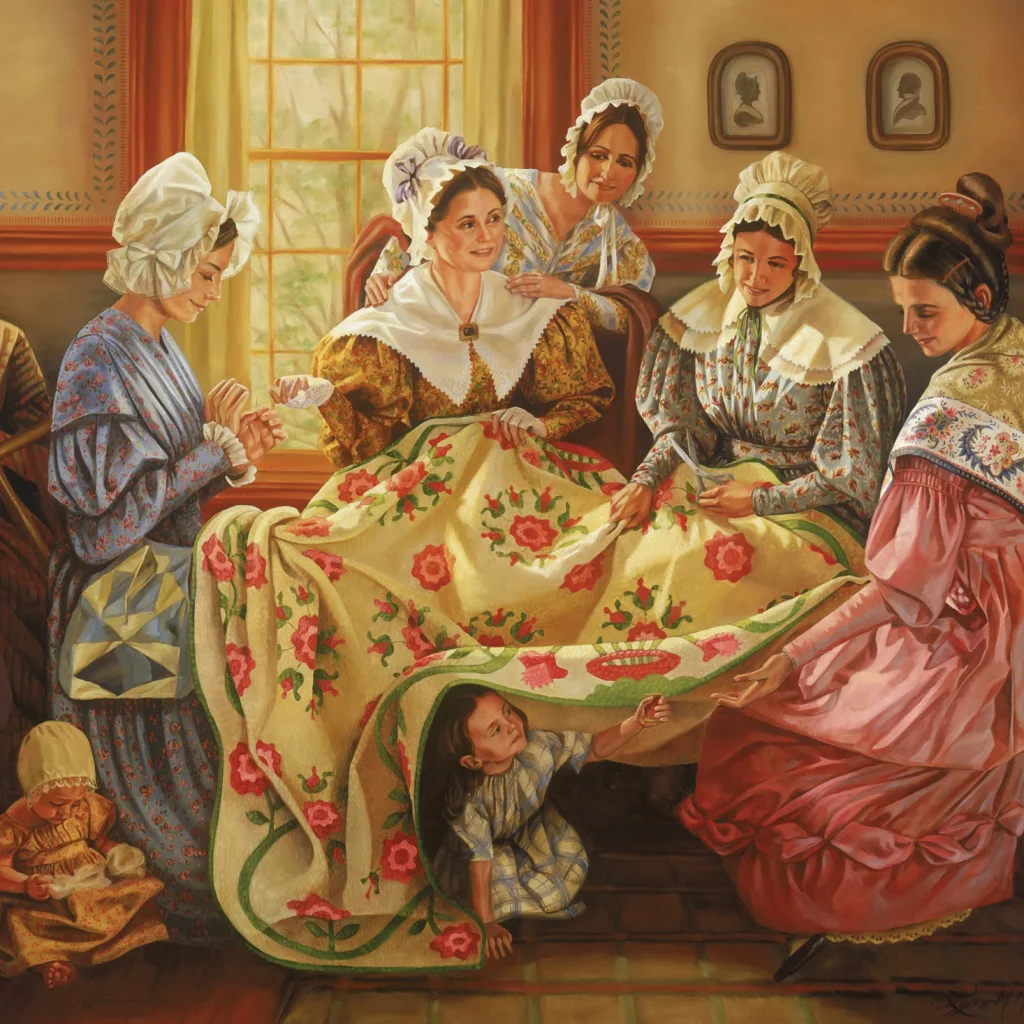
Lynde Mott
Quilting Bee
Oil on canvas
Quilting bees were a cornerstone of social life, especially for women in rural America. They provided a space for women to gather, share stories, and collectively create quilts. These informal gatherings reinforced social bonds and allowed oral histories to be passed down, preserving not only quilting skills but also the narratives of the families and communities involved.

Martha Washington Quilters Guild, 2022
Photo courtesy of Washington City Mission
Modern quilt guilds continue the legacy and historical tradition of quilting bees by combining the craft of quilting with community engagement through organized meetings, workshops, and exhibitions.
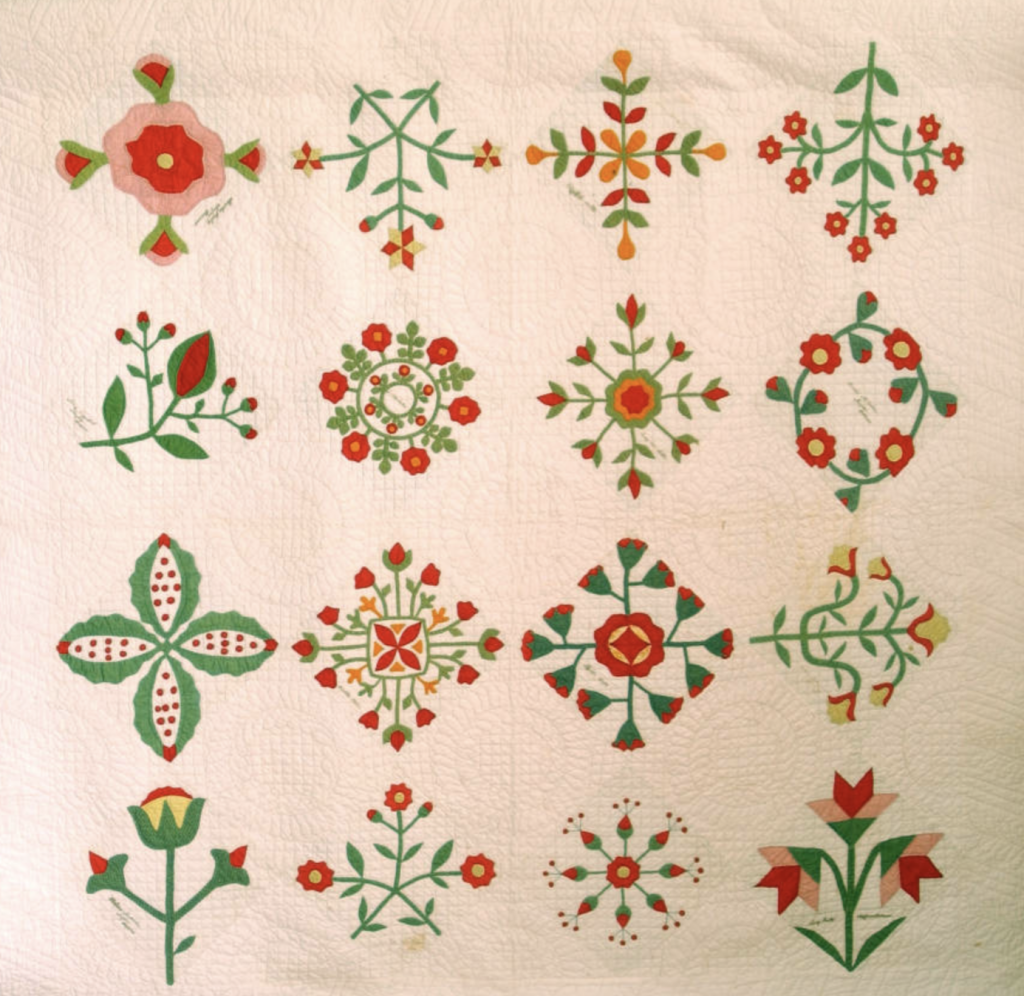
A collective of women from Clinton County, Ohio and Wayne County, Indiana.
Hadley Abolitionist Quilt, 1842
Photo courtesy of The Ohio History Connection
The Hadley Abolitionist Quilt was crafted in 1842 by anti-slavery Quaker women from Clinton County, Ohio, and Wayne County, Indiana. This signature quilt reflects their active opposition to slavery, a stance that separated them from mainstream Quaker meetings.
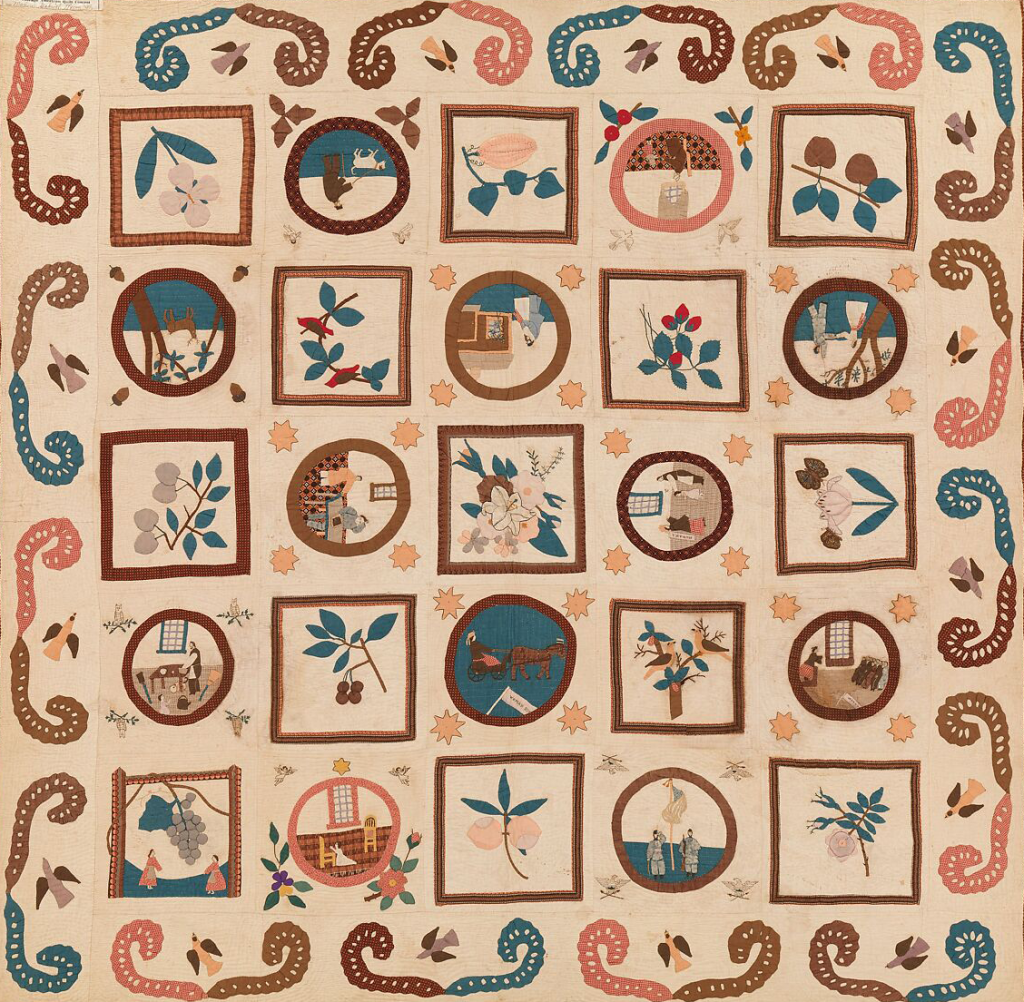
Emma Civey Stahl
Woman’s Rights Quilt, 1875
Collection of the Metropolitan Museum of Art, NYC
In the late 19th century, quilts were used as a means of activism during the women’s suffrage movement, incorporating symbols of progress and images of leading suffragists. These works served as both art and advocacy, raising awareness and rallying support for women’s right to vote.

Lucinda Ward Honstain and/or Emma Honstain Bingham
Reconciliation Quilt, 1867
Brooklyn, New York, dated November 18, 1867
Cotton; hand pieced and appliquéd, embroidered, hand quilted International Quilt Museum
Ardis and Robert James Collection, IQM 2001.011.0001
This quilt documents personal and historical moments from post-Civil War America. Featuring figures such as a Black man declaring “Master, I am Free,” it reflects themes of reconciliation and social identity.
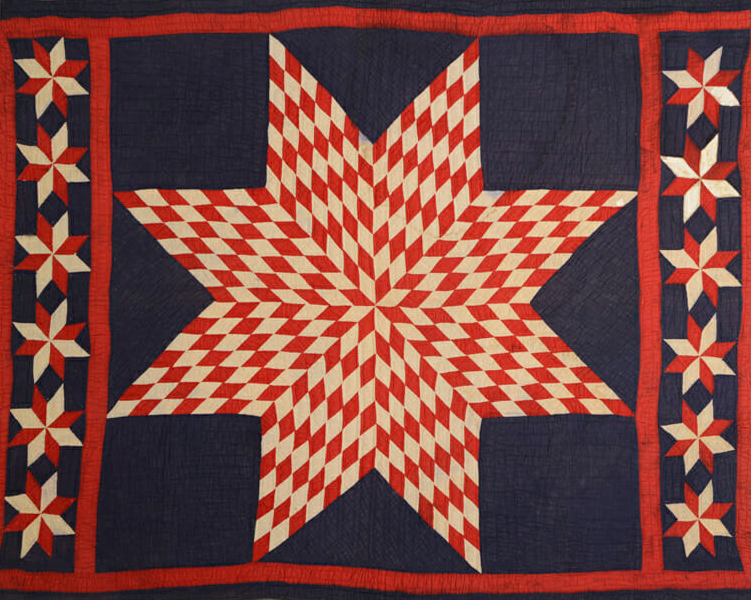
Maker unknown
Star of Bethlehem, 1917
Made in the United States, dated 1917
Cotton; machine pieced, hand quilted
International Quilt Museum, Sue Reich Collection, IQM 2021.021.0004
World War I, also known as the “Great War,” greatly influenced American quiltmaking. From April 1917 to March 1919, women created quilts that served as historical documents, capturing personal loss, patriotic fervor, and the collective effort to support the Red Cross. Thousands of quilts were made as part of one of the greatest benevolent efforts of the twentieth century. The unidentified maker of this quilt inscribed it on the reverse, “Made for my son. T. Cox. 1917.”

Red Cross quilt Dorcas Sunday School Class, dated 1917
Made in the United States
Cotton; Machine appliquéd and pieced, embroidered. International Quilt Museum, Acquisition made possible by Robert & Ardis James Fund, IQM 2011.013.0001
During the First World War, quilts were sewn and distributed by the Red Cross to soldiers and civilians affected by wartime devastation. This tradition continued through World War II, with volunteers across the U.S. making quilts to provide warmth and comfort to those in need. Organized by the American Red Cross, these efforts became powerful symbols of resilience, solidarity, and community support during times of global conflict.

Maker unknown
Victory Jacket, circa 1942-1945
Made in United States
Cotton; Foundation pieced, machine appliquéd and constructed International Quilt Museum, Acquisition made possible by Robert & Ardis James Fund,
IQM 2009.017.0003
During World War II, many American women expressed their patriotism and resourcefulness through quilting and textile arts. This handmade Victory Jacket belonged to a woman who stitched a bold “V” and the Morse code for “Victory” onto the fabric, symbolizing the country’s wartime campaign. With rationing in effect, quilters repurposed materials, embodying the “make-do” spirit of the era.
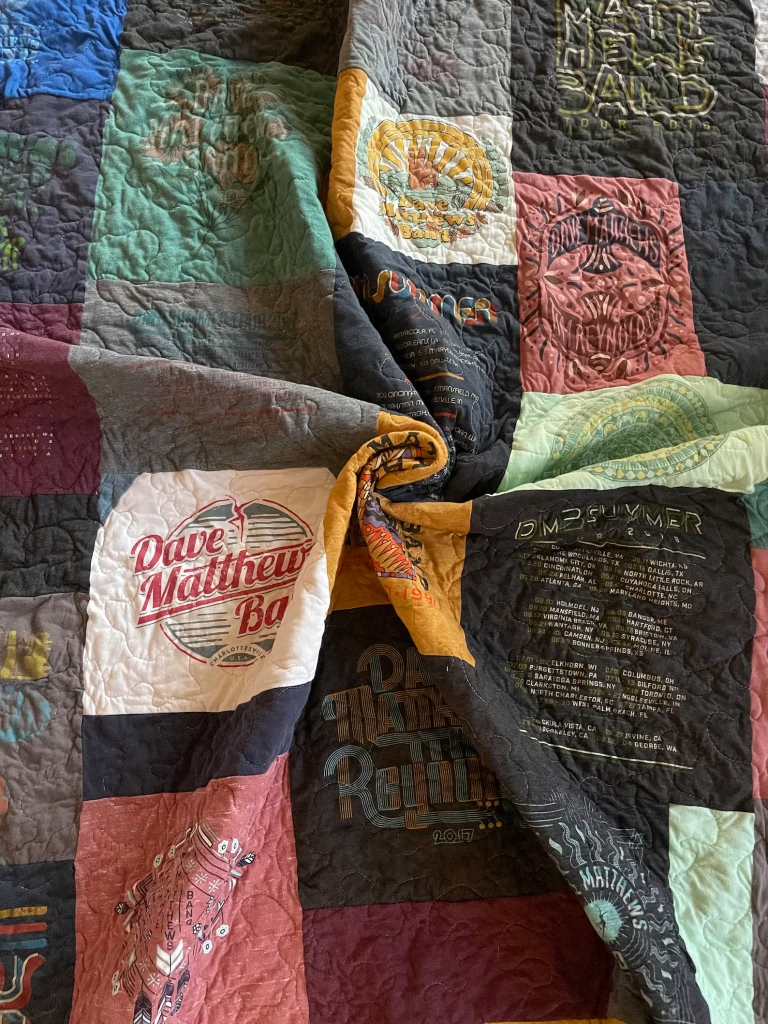
Kristen Danis
Memory T-shirt Quilt
Photo Retrieved from etsy.com/shop/kdanis
Memory quilts are a longstanding tradition in American quilting, preserving personal and family histories through fabric. Signature quilts, popular in the 19th century, featured names and messages from loved ones, often as farewell or community gifts. T-shirt quilts, a modern adaptation, repurpose garments from special events, transforming them into meaningful keepsakes. Whether made from clothing, handwritten notes, or embroidered patches, memory quilts serve as tangible reminders of life’s milestones and relationships.
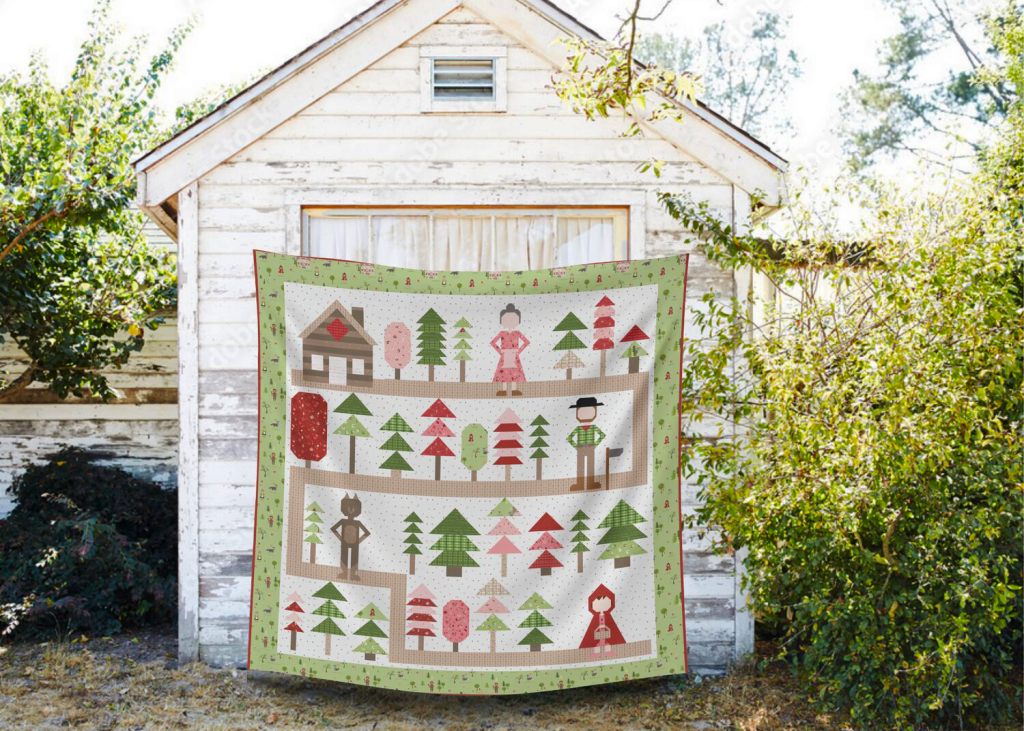
Jennifer Long
Through the Woods, 2024
Photo Retrieved from https://www.diaryofaquilter.com/journey-through-the-woods-with-sew-a-story/
This quilt by Jennifer Long reimagines the tale of Little Red Riding Hood as a narrative stitched in fabric. Beginning in the bottom right corner, the quilt follows Little Red through the forest, encountering familiar faces, and ends in a warm, welcoming scene at Grandma’s home.
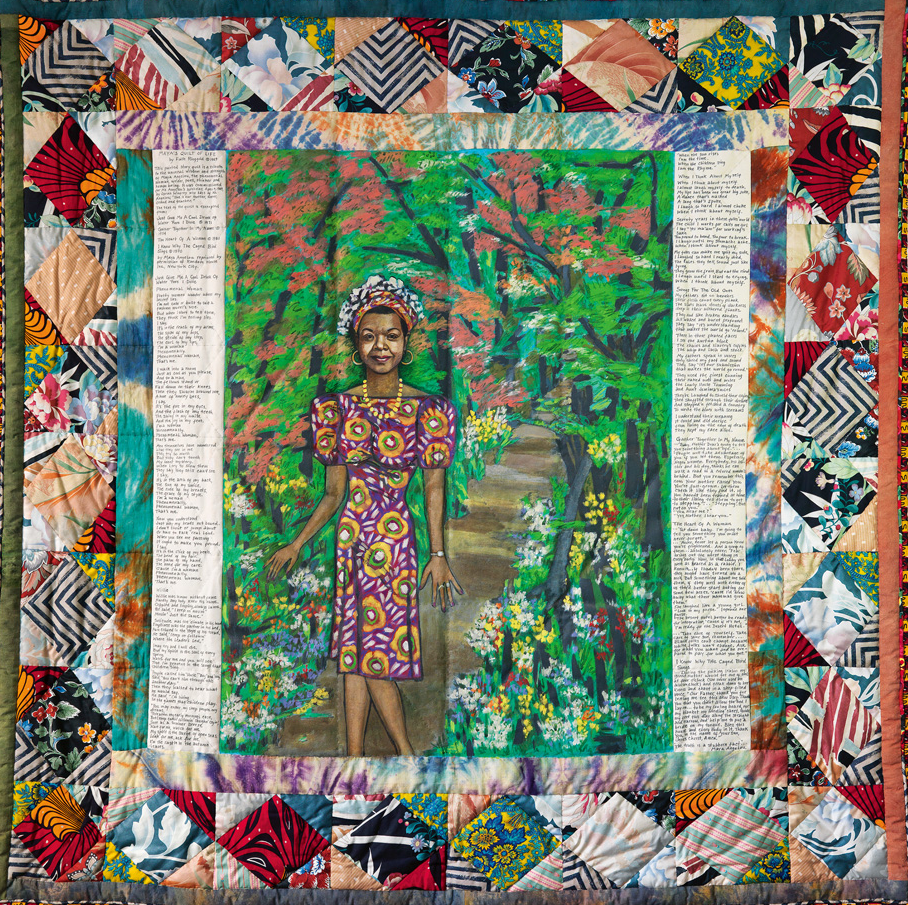
Faith Ringgold
Maya's Quilt of Life, 1989
Photo retrieved from Swann Auction Galleries’s Website
Faith Ringgold is renowned for her painted story quilts, which unite a tradition of representational painting with the rich history of quilting in the African American community. Maya’s Quilt of Life, commissioned by Oprah Winfrey for Maya Angelou’s 61st birthday, features a vibrant border of fabric framing Angelou in her signature patterned African dress. The quilt includes excerpts of her literary works, including I Know Why the Caged Bird Sings, celebrating her legacy through art and storytelling.
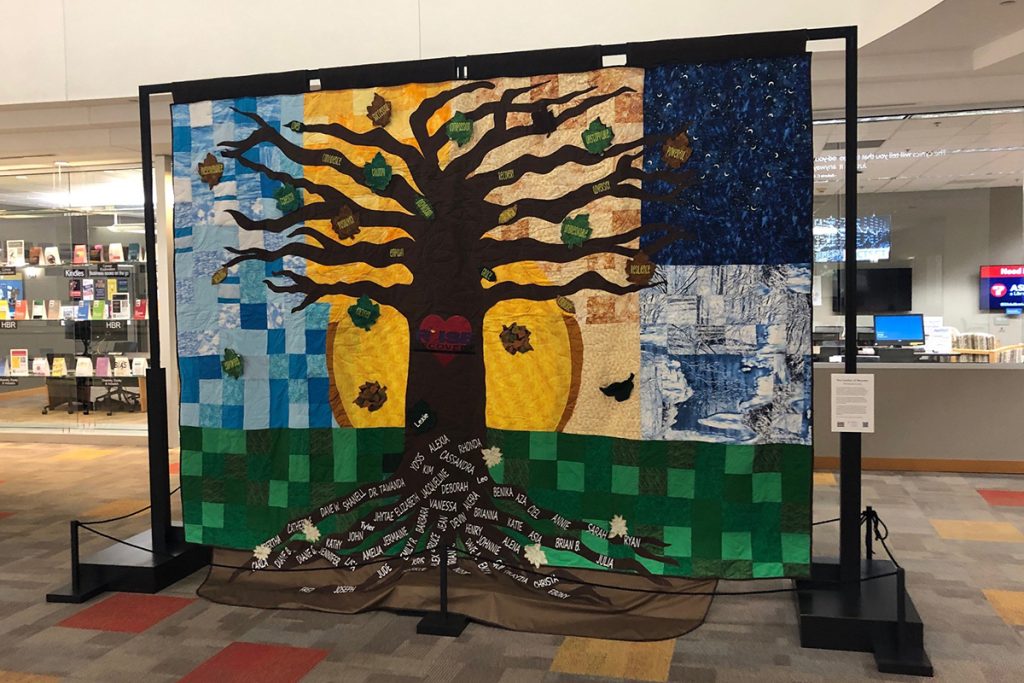
Various contributors
The Comfort of Recovery Quilt, 2022
Rise2Recovery (R2ISE Theatre)
Photo retrieved from the Emory University News Center website
Created through a partnership between R2ISE to Recovery and the Michael C. Carlos Museum, The Comfort of Recovery Quilt is a collaborative piece symbolizing healing, resilience, and community, featuring a central tree with contributors’ names stitched into its roots. Over 100 people participated, weaving personal experiences of addiction recovery into the fabric.
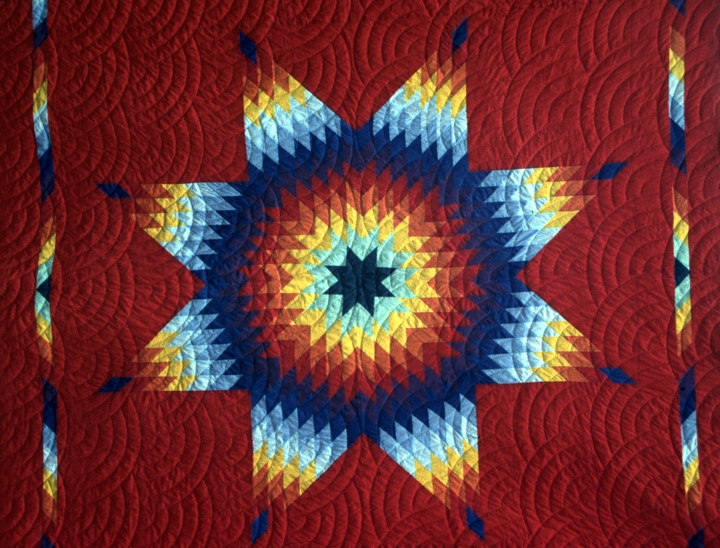
Nellie Star Boy Menard
Star Quilt (Detail)
Photo retrieved from the National Endowment for the Arts website
Quiltmaking may be both the most widespread and the least known of Native American traditional arts. Although the full details of when and how Native Americans took up this European domestic art form are not known, it is clear that by the mid-19th century, quilting was fairly widespread among a number of Indian tribes.
In Sioux culture, an accomplished traditional quiltmaker is measured not only by a mastery of needlework techniques, but by the creative use of the star motif and of traditional aesthetic principles. Star quilts are often given as gifts to mark important life events, such as births, graduations, and ceremonies, serving as symbols of honor, spirituality, and community.Photo retrieved from the National Endowment for the Arts website
Russian Quilting
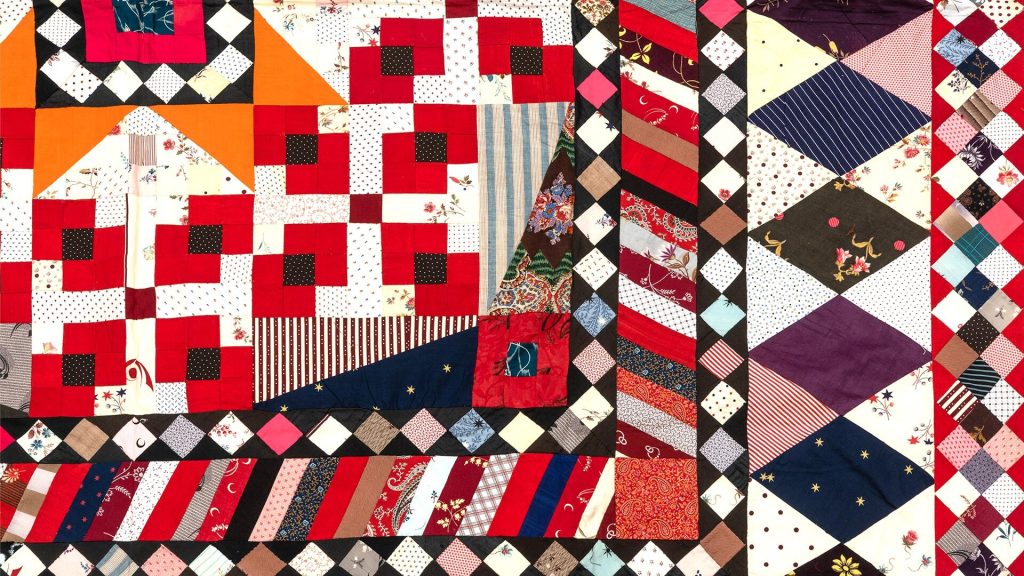
Late 19th Century patchwork panel from Kazan
Maker and title unknown
Collection of the State Russian Museum
Traditional Russian patchwork coverlets (Paduas) were made by rural families, often using colorful, geometric patterns for warmth and decoration. Embroidered with symbolic motifs like the Tree of Life, they symbolized protection, fertility, and family ties.
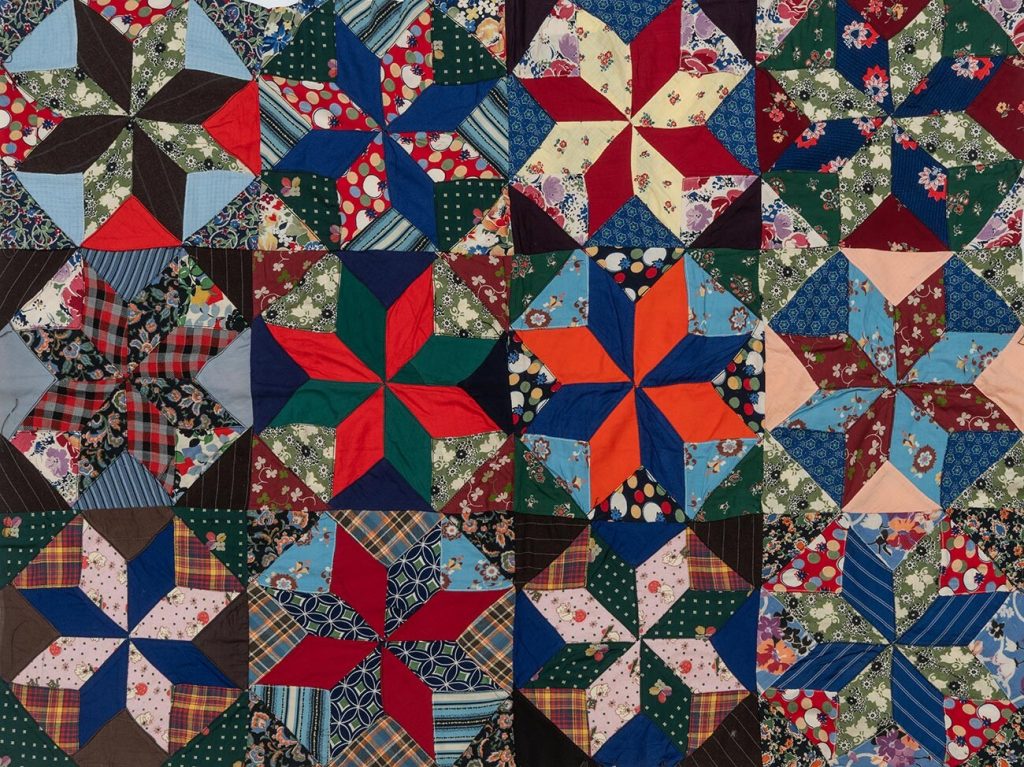
F.V. Brovtsina
Patchwork Quilt, 1979
Made in Kortala Village, Leningrad Region
Collection of the State Russian Museum
During the Soviet era, quilting prioritized functionality over artistic expression. Mass-produced geometric designs aligned with Soviet ideals of simplicity and national productivity. Influenced by Constructivism in the early 20th century, some quilts featured bold, industrial-inspired designs.
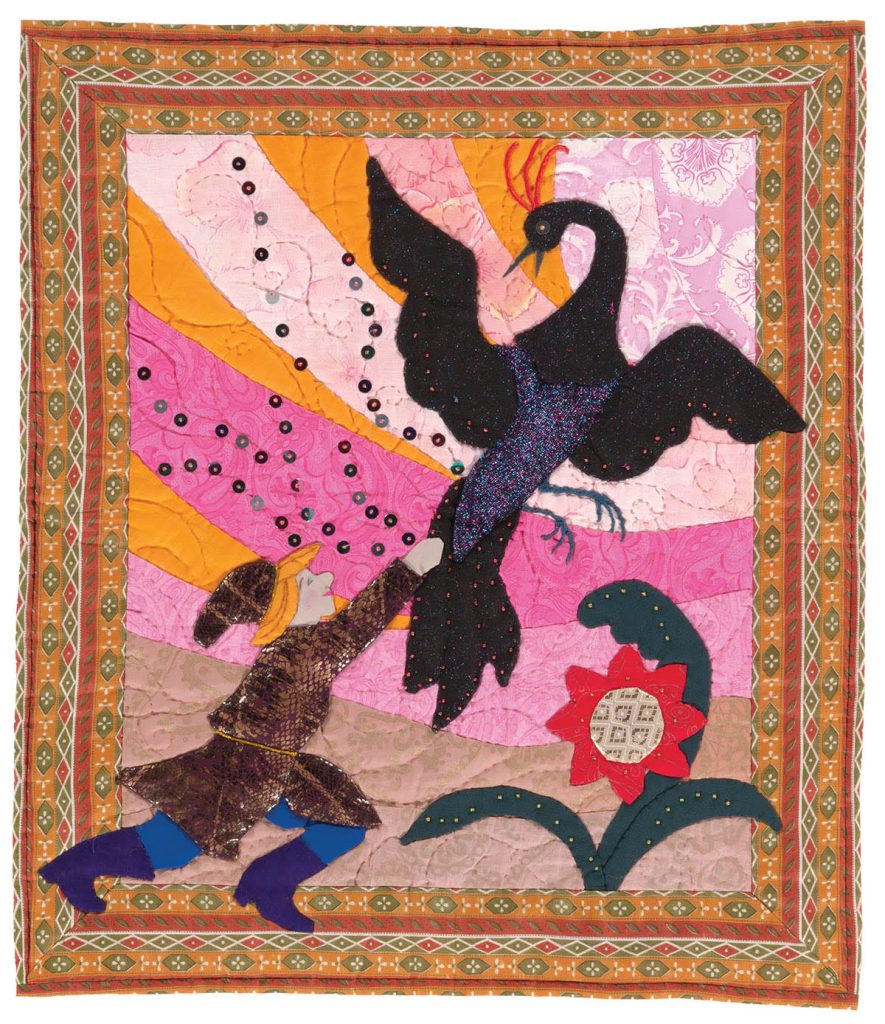
Galina Kokorina
The Firebird, circa 2000
Made in Vladimir, Russia
Cotton; Machine pieced, hand appliquéd
International Quilt Museum, IQM 2018.008.0008
Quilting communities are becoming increasingly active in Russia, with modern quilters engaging in both traditional and contemporary techniques. Popular online platforms like Instagram and VKontakte allow Russian quilters to share their works, exchange techniques, and create global connections within quilting networks.
Quilts from Ambassador Tracy’s Collection
Ambassador Tracy began collecting quilts as a diplomat about 15 years ago, partly to showcase American culture and traditions in the places where she served. Most of the quilts in Ambassador Tracy’s collection were acquired at the annual Ohio Mennonite Relief Sale. Each year, community members create and donate unique quilts to be auctioned off at the sale. All proceeds support people in need. While some of these quilts are hand crafted, many are machine-sewn. While machine quilting did not formerly enjoy the reputation of traditional quilting, it has now gained respect in the quilting community, not least because of the intricate sewing patterns a quilter is able to produce with a machine.
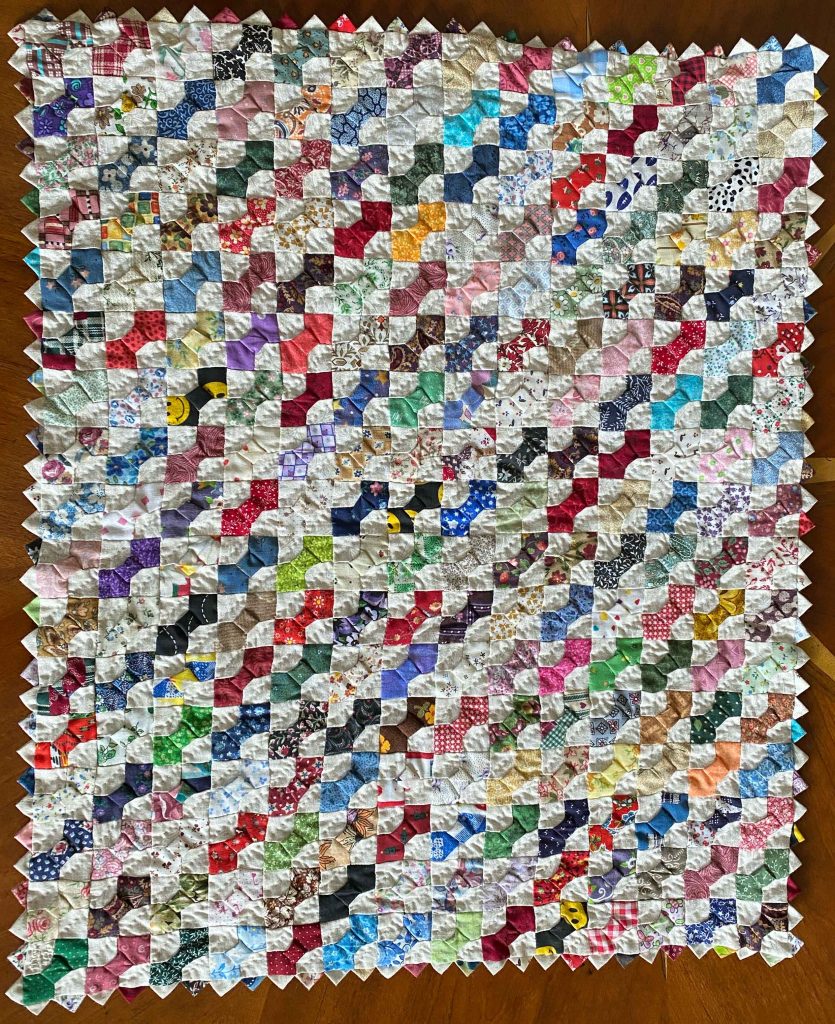
Bowtie Quilt
From Ambassador Tracy’s Collection
This quilt shows off the bowtie quilting pattern, which uses many small pieces of fabric from countless sources, twisted and sewn into connecting bowties.
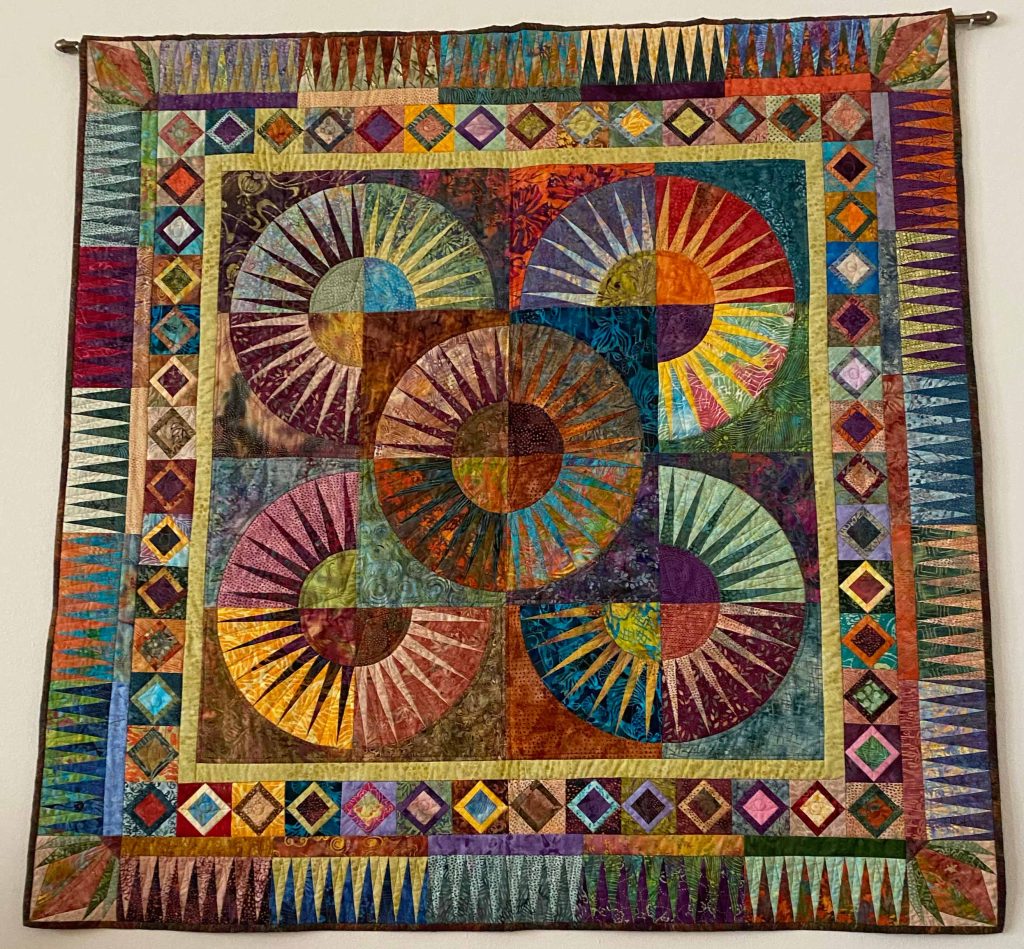
Fireworks Quilt
From Ambassador Tracy’s Collection
This quilt, titled “Fireworks,” impresses with its vibrant color scheme. Currently displayed in the Music Room at Spaso House, this quilt was featured as part of the thematic art for the U.S. Embassy Moscow’s Independence Day event in 2024.
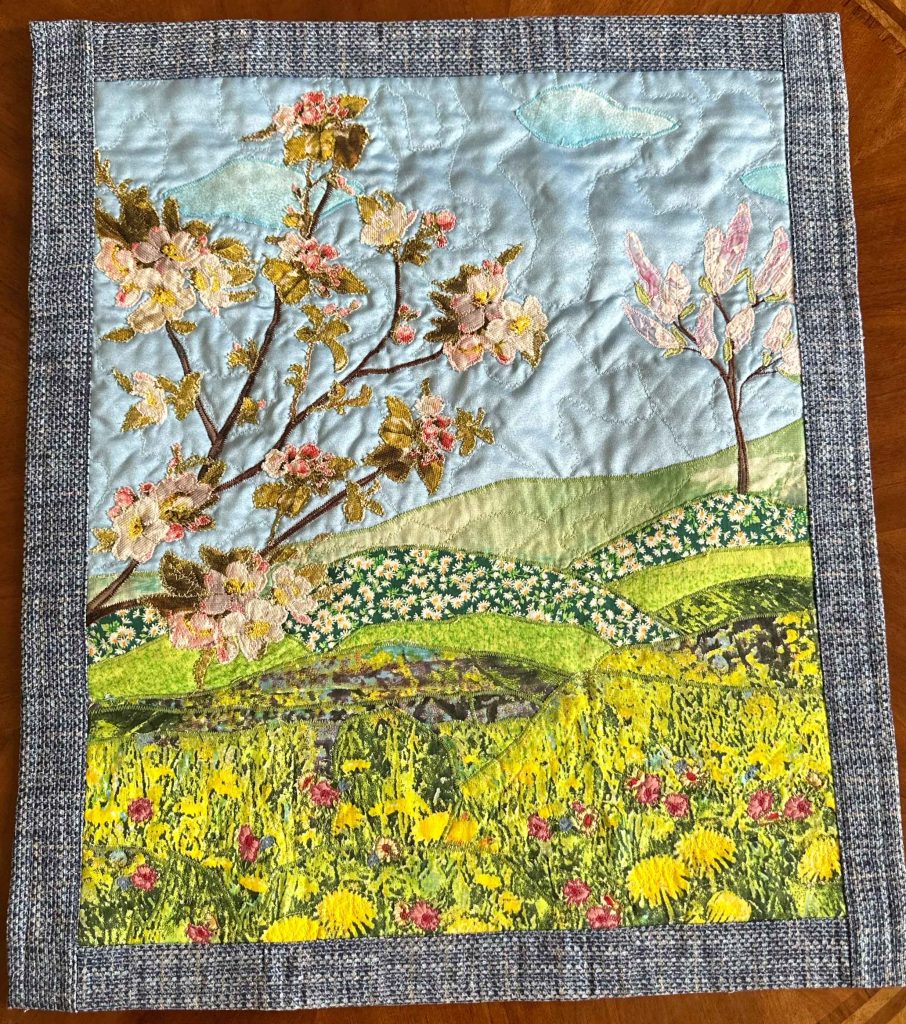
Russian Quilt
From Ambassador Tracy’s Collection
This is the Ambassador’s first Russian quilt, acquired at a vendor fair held at the U.S. Embassy. Created using the applique technique, it layers many different types of fabric to form detailed landscapes and a sense of depth.

Flying Geese Quilts
From Ambassador Tracy’s Collection
These two “Flying Geese” quilts are good examples of machine work on fabric. These seemingly simple designs reveal their intricate details upon closer look at the variety of fabric types and sewing techniques used to create them.
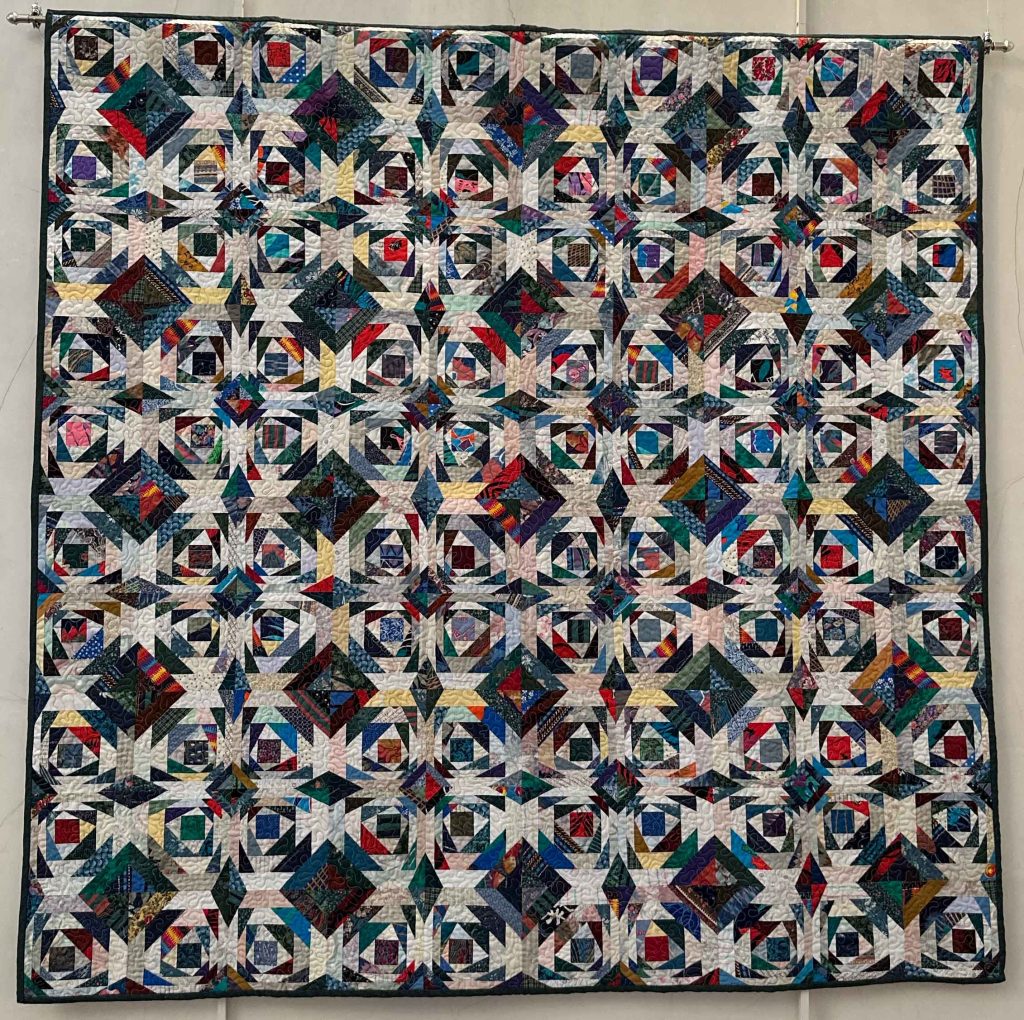
Kaleidoscope Quilt
From Ambassador Tracy’s Collection
This intricate “Kaleidoscope” quilt was made from two bags of fabric ends – leftover cloth scraps from other projects.

Blooming Dresdens Quilt
From Ambassador Tracy’s Collection
This quilt showcases the applique technique, where fabric is sewn on top of other fabric. This quilt also illustrates the use of buttons and other material to add texture and create different effects.
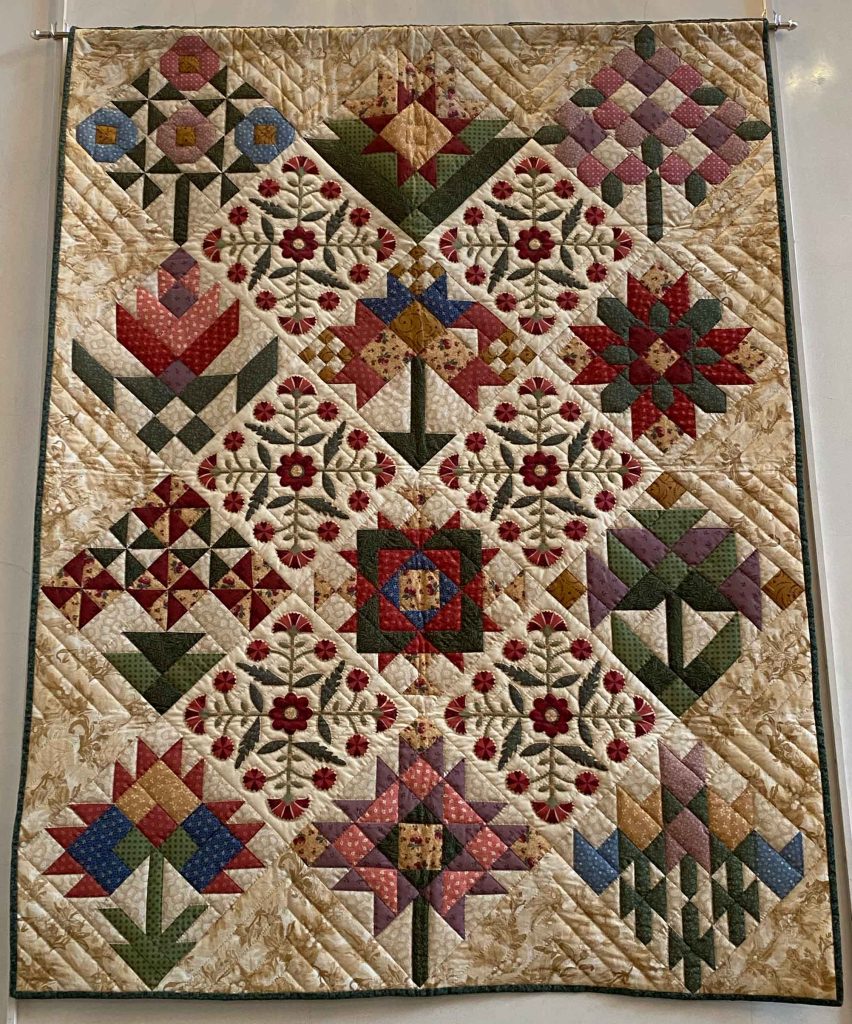
Hartville Quilt
From Ambassador Tracy’s Collection
This quilt is hanging in the Chandelier room at Spaso House. It was crafted by an Ohio church community and donated to the relief auction.

Ohio Star Quilt
From Ambassador Tracy’s Collection
This quilt showcases a beloved geometric quilt pattern from Ohio, the Ohio Star. This pattern is a classic nine-patch block featuring a central square, surrounded by four quarter-square triangle units, and four plain corner squares.
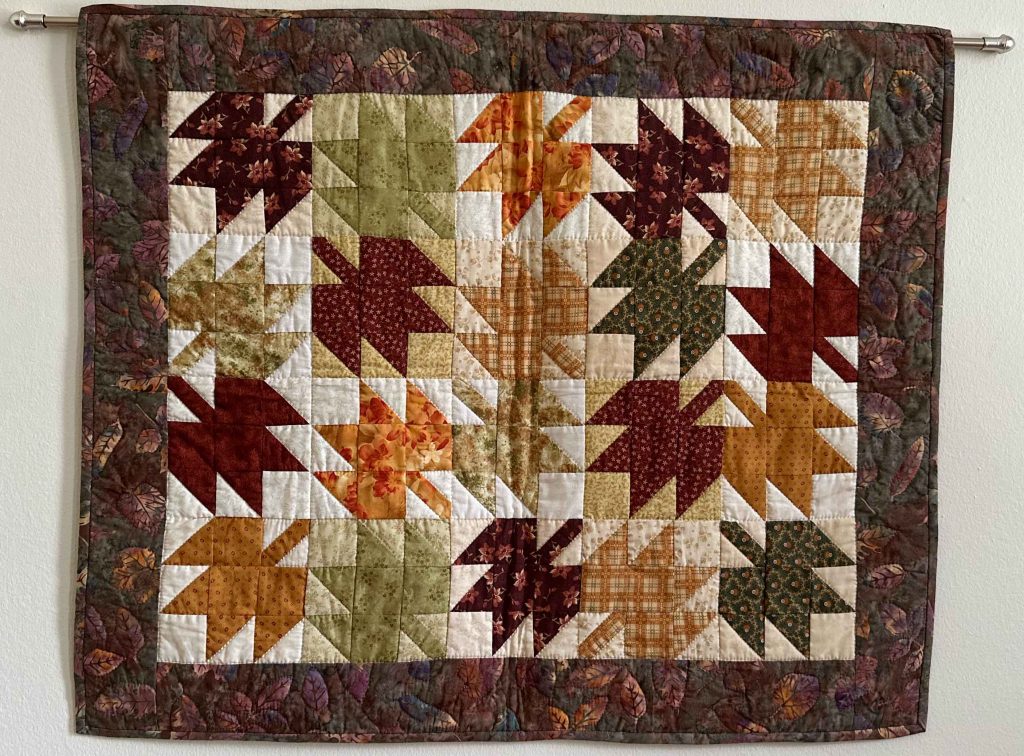
Bear Claw Quilt
From Ambassador Tracy’s Collection
This quilt illustrates the “bear claw,” a classic quilt block pattern that resembles a bear’s footprint. The pattern is a four-patch block featuring a central square, surrounded by four “claw” units composed of right-angle triangles and small squares.
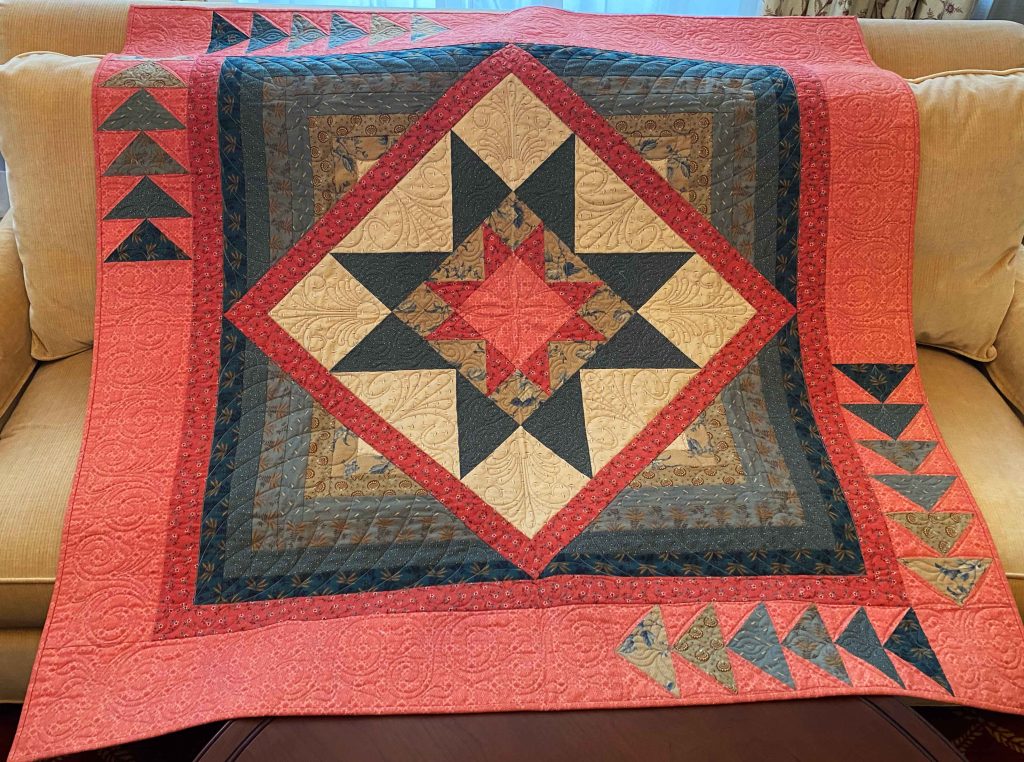
Red Star in Middle Quilt
From Ambassador Tracy’s Collection
This quilt boasts a mix of patterns, including “flying geese” that are often used for borderwork.
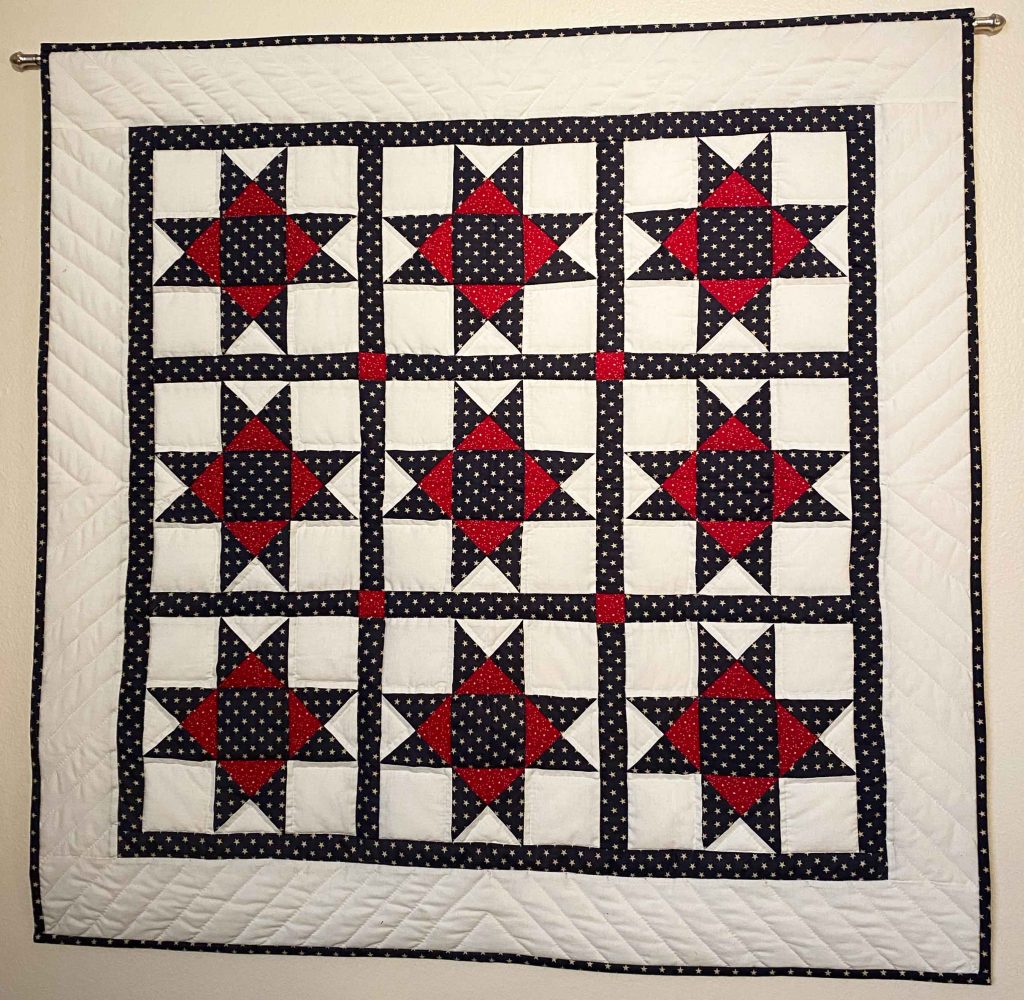
Ohio Star Quilt in Red, White, and Blue
From Ambassador Tracy’s Collection
This quilt also features the Ohio Star pattern, but in red, white, and blue patriotic colors. This quilt hung in Ambassador Tracy’s residence when she was serving as Deputy Chief of Mission in Moscow.
